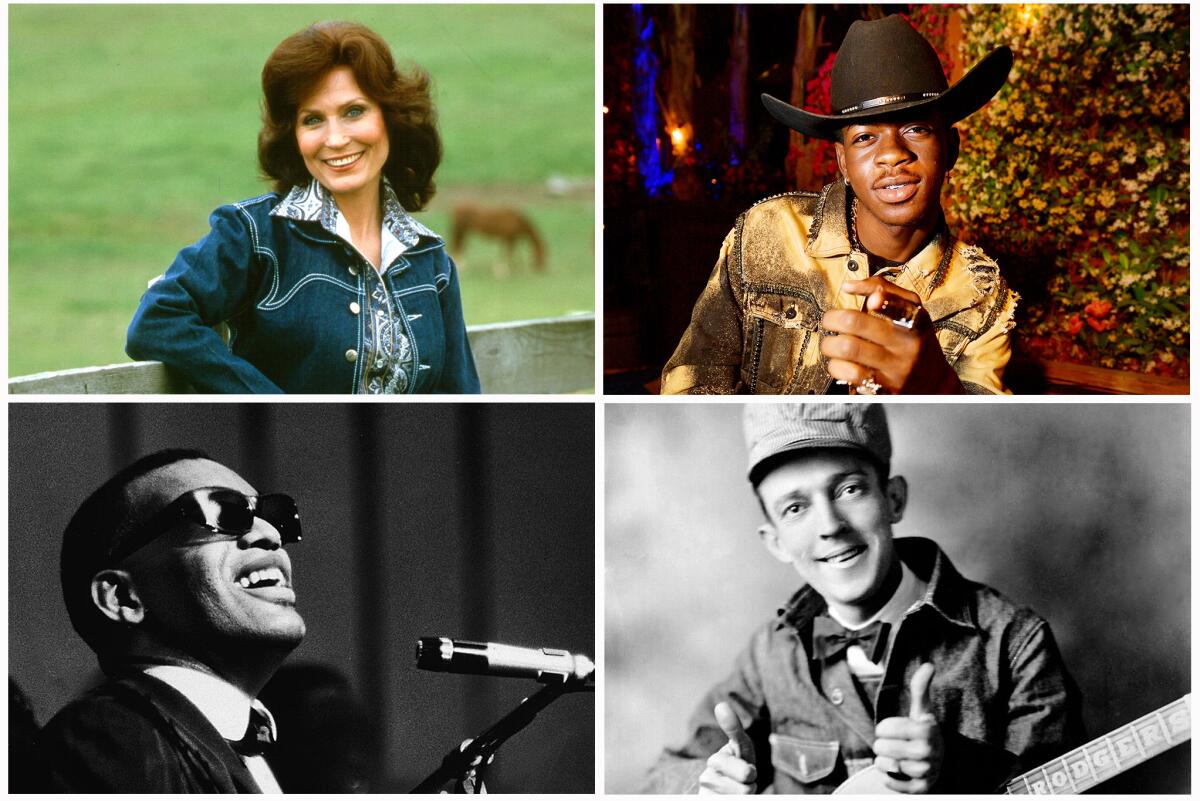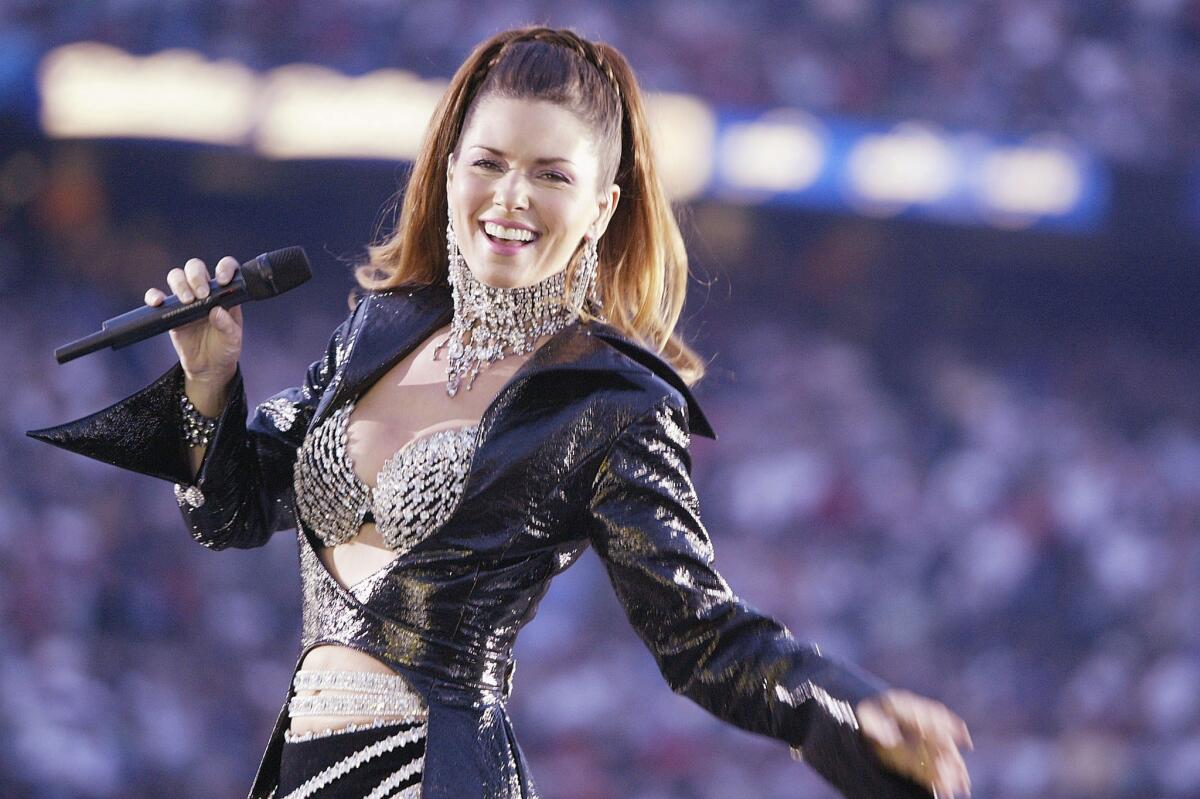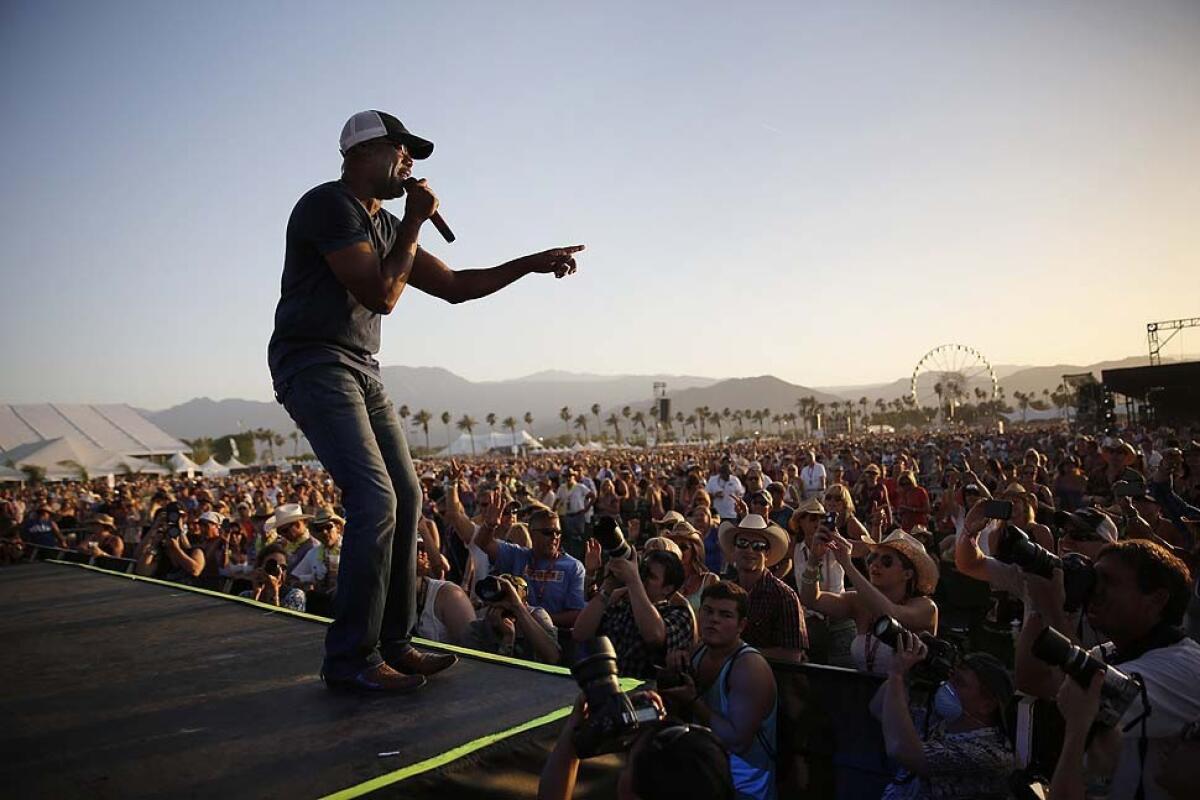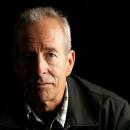In 2019, country music has a raging identity crisis. For Ken Burns, that’s a 100-year-old story

- Share via
On the surface, rapper Lil Nas X’s record-setting smash “Old Town Road” seems to have little connection with the forthcoming multipart film documentary “Ken Burns’ Country Music.”
One is an offhandedly radical merging of two styles of music — hip-hop and country — that historically have occupied distant ends of the musical spectrum; the other is a measured, exhaustively researched examination of nearly a century of American music and cultural history.
The common element, however, is that both hone in on and illuminate — without definitively answering — the same question: What is “country music”?
“Old Town Road” has engendered countless debates, and probably more than a few bar fights at a jukebox, over its country music credentials. What defines country music, and distinguishes it from other forms of popular music, also is at the heart of Burns’ eight-part, 16½-hour series, which premieres Sept. 15 on PBS.
From Loretta Lynn to Chris Young, 10 hit songs in which country music brags about its identity crisis
Veteran songwriter Harlan Howard famously asserted that “Country music is three chords and the truth.” In one of many revealing juxtapositions over the course of Burns’ series, critically acclaimed singer-songwriter Rodney Crowell agrees, then points out: “It’s about the truth, even when it’s a big, fat lie.”
Other artists have taken stabs at crystallizing what they do. “Country songs are the dreams of the working man,” Merle Haggard said. Waylon Jennings offered a broadly inclusive outline: “Country music isn’t a guitar, it isn’t a banjo, it isn’t a melody, it isn’t a lyric. It’s a feeling.”

Hank Williams himself addressed the question, saying, “You ask what makes our kind of music successful. I’ll tell you: It can be explained in just one word: sincerity.”
Veteran filmmaker Burns and his New Hampshire-based crew spent more than eight years, conducted more than 175 hours of interviews with more than 100 subjects, pored over thousands of photographs and feet of vintage film footage, and crisscrossed the nation in making their exploration of that quintessentially American style of music.
Yet ask Burns or the show’s writer, Dayton Duncan, to define country music, and despite — or perhaps because of — the depth of their research, you’re likely to get an enthusiastic, richly informed dissertation rather than a pithy bromide. But not for lack of trying.
“One of the central themes of our film is that country music isn’t, and never was, just one style of music,” Duncan said recently. “That’s probably the biggest thing that kept hitting me in the face doing the research.
“From the get-go,” he said, “it’s been a mixture of hymns and blues and minstrel songs and work songs and sentimental songs and old work songs and ballads from the British Isles. It never did congeal into any one thing. I’m mixing my metaphors here, but it came from many roots and then started its own branches.”

Today those branches include significant elements of pop, rock, R&B and hip-hop music, nowhere more up front than in “Old Town Road.” Those genres have intersected with and informed “traditional” country music increasingly over the last decade or more.
Among the most prominent examples: Jason Aldean’s 2011 hit “Dirt Road Anthem,” Sam Hunt’s breakthrough 2017 single “Body Like a Back Road,” pop-R&B singer-songwriter Bebe Rexha and country duo Florida Georgia Line’s No. 1 2017 collaboration, “Meant to Be” and Kane Brown’s new duet with EDM producer and DJ Marshmello, “One Thing Right.”
For Burns himself, a key mission of his project has been to look beyond the clichés and the quips often served up about country music to reveal its origins in some of the poorest regions of America’s rural South, as well as to highlight often deceptively simply stated expressions of the subjects country songs address.
“There’s something that we do in our culture in which we’re OK with sentimentality and nostalgia,” Burns said. “I don’t know why, but that’s the enemy of good anything. We’re frightened of real, deep emotions. So we mask [discussions of country music] with jokes about pickup trucks, dogs, girlfriends and the beer.
“When in fact,” he added, “it’s about elemental things: birth, death, falling in love, out of love, seeking redemption and erring and all the things human flesh is heir to. That’s the stuff country music is about.”
“It is part of who we are as Americans — as much as the New Deal and the Civil War and the slave trade,” said Rosanne Cash, a key voice in Burns’ film, commenting both from the perspective of an outsider who fought to establish her own musical identity in the late 1970s, and as the daughter of country icon Johnny Cash. “All the violence and all the beauty — it’s part of who we are, and we should know it.”
“They wouldn’t let you do anything”
Forward-thinking musicians have challenged assumptions about what qualifies as country music — about what is “authentically” country — nearly since the beginning.
Pioneering singer and songwriter Jimmie Rodgers hailed from Meridian, Miss., where he grew up hearing the work songs, field hollers, blues laments and gospel music of African Americans. In 1929 he teamed with the most influential African American musician of the early 20th century, New Orleans trumpeter and singer Louis Armstrong, and his wife, pianist Lil Hardin Armstrong, who added jazz licks to Rodgers’ recording “Blue Yodel No. 9.”

In the 1930s, Texas-bred musician Bob Wills, like millions of his contemporaries around the country, was smitten by the sound of big-band swing music. He put his own spin on the genre, focusing on fiddles instead of clarinets and trumpets and giving birth to the country genre of western swing.
Kentucky singer-mandolinist Bill Monroe transformed the mountain music he heard around him in Appalachia, grafting a musical proficiency and intricate vocal harmonies that rivaled jazz and classical music in establishing the “high lonesome sound” that came to be known as bluegrass music.
In the 1950s, Nashville attempted to stem the swelling tide of rock ’n’ roll in capturing the fascination of America’s youth. So leading record producers Owen Bradley and Chet Atkins turned toward a more sophisticated sound they hoped would draw in the parents of rock-obsessed young listeners. Banjos, fiddles and steel guitars were downplayed, replaced by sweeping orchestral accompaniment and background choirs for what became known as “The Nashville Sound,” exemplified in hits from the period such as Patsy Cline’s recording of Willie Nelson’s song “Crazy,” Don Gibson’s “Oh Lonesome Me” and Jim Reeves’ “Four Walls.”

“Now we’ve cut out the fiddle and steel guitar and added choruses to country music,” Bradley once said. “But it can’t stop there. It always has to keep developing to keep fresh.”
A jolt of such freshness came in the early ’60s, when soul music great Ray Charles first gained artistic control of his time in the recording studio. He radically reimagined a batch of country songs for his 1962 album “Modern Sounds in Country & Western Music” with big band accompaniment and his blues and gospel-drenched vocals.
Meanwhile, musicians based in Bakersfield were recording much of their music at Capitol Records in Hollywood. The two kingpins of “the Bakersfield Sound” were Buck Owens and Merle Haggard, who had no qualms against steel guitars and fiddles and threw electrified Fender guitars into the mix to add a dose of rock ’n’ roll energy to their recordings.

The smooth, adult bent of Nashville continued into the ’60s, sparking another rebellion among a loose crew of musicians who bridled at the restrictions imposed on them.
Willie Nelson recorded with little success trying to squeeze his idiosyncratic, jazz-inflected vocals into Nashville’s square hole, as did Waylon Jennings, whose assertion of their artistic independence sparked the “Outlaw Movement” of the 1970s.
“They wouldn’t let you do anything. You had to dress a certain way: you had to do everything a certain way,” Jennings once told an interviewer. “They kept trying to destroy me. ... I just went about my business and did things my way.”
Johnny Cash pushed at the boundaries of country convention by recording and releasing a string of concept albums about social issues he passionately believed in, while Loretta Lynn tested radio’s loyalty to her homegrown music with proto-feminist songs drawn from her hardscrabble life, one of which was banned by some stations: her 1975 single “The Pill,” which celebrated the new level of control the oral contraceptive gave women over pregnancy.
More debates over country’s identity sprouted in the late 1970s and early ’80s. After “Saturday Night Fever” fueled a craze for disco music and clubs, the film’s star, John Travolta, took on country music next with his starring role in “Urban Cowboy.” That film sparked a national upsurge in interest in country music and coincided with a raft of pop-leaning country hits at the time, including Dolly Parton’s “Here You Come Again” and “9 to 5” and Eddie Rabbitt’s “I Love a Rainy Night.”

A different kind of challenge arose in the mid-’80s when country loosened up enough to give rise to a freshman class of literate, critically acclaimed acts including Dwight Yoakam, Lyle Lovett, k.d. lang and Steve Earle.
Progressive country lit up the charts during that short-lived era Earle likes to call “the great credibility scare of the mid-’80s,” just before the arrival of Garth Brooks, Alan Jackson, Clint Black and other so-called “hat acts” of the ’90s pushed those predecessors aside, into the newly emerging wing called “Americana.”
Shortly after the dawn of the new millennium, Texas country rapper Cowboy Troy generated headlines and further controversy when he put forth a musical hybrid he deemed “hick-hop.” A one-liner tossed out commonly by comedians and some country musicians was built around the punch line that a combination of country and rap equals “crap.” It wasn’t long, later, however, before country with rap breakdowns began cropping up with greater frequency in the wake of the breakaway success of Aldean’s “Dirt Road Anthem.”
“When people complain about country going pop, what they often mean is country is sounding too black,” said historian Charles Hughes, author of “Country Soul: Making Music and Making Race in the American South” and director of the Lynne & Henry Turley Memphis Center at Rhodes College in Memphis. “The entire history of the genre has wrestled with people who are not considered to be part of the country family, and ‘Old Town Road’ is just the latest manifestation of that.”
One thread running through country music almost since the beginning, and which tacitly connects it to today’s buzz over Lil Nas X, is the recurring debate over new elements that work their way in. Each time the argument surfaces, some fans moan that such changes are diluting “true” country; others parry that fresh ingredients strengthen and expand its reach.
“Fans of country music are invested in the identity of the genre in a way that a lot of pop music genres aren’t,” Hughes said. “You hear similar arguments at various times in hip-hop: ‘Did hip-hop sell out?’ But there are few genres in which there’s such a deep investment in the question, and you hear that in the music itself.”
That question has been heard loudly and clearly in 2019 surrounding “Old Town Road,” which spent 19 weeks atop Billboard’s Hot 100 singles chart, an all-time record. Even more recently, Atlanta musician Blanco Brown’s dance-floor-minded, steel-guitar-driven hit “The Git Up” has spent nearly two months atop of Billboard’s Hot Country Song chart.
“Fans should be the judge of a song’s genre,” Billy Ray Cyrus told The Times last week by email. Cyrus famously pitched in on a remix to help bolster “Old Town Road’s” country credentials. “Music has always evolved sonically and there will always be naysayers. Country fans requested and wanted ‘Old Town Road’ played on radio. It’s the people’s song. They made it a success.”

Whether “Old Town Road,” “The Git Up” or other tracks that buck tradition qualify as country is, on one level, an easy call, said Chuck Aly, vice president and general manager for Country AirCheck, a radio monitoring service. “The answer for me is the airplay charts, and for us, country music is what’s on the charts.”
Yet country radio has long been resistant to innovation, both in terms of gender and race, whether it was singer Charley Pride, whose music was initially sent out by his record label in the ’60s with no photos to give away the fact that he is black, or stations that refused to play Lynn’s “The Pill.” .
Indeed, female musicians have faced an uphill battle to win airplay on country radio going back to the 1930s, despite the pioneering contributions noted in Burns’ film of influential figures such as Maybelle and Sara Carter of the Carter Family, Patsy Montana, Kitty Wells, Cline, Lynn, Parton, Tammy Wynette, Emmylou Harris and Rosanne Cash, among others.
Combine that with the hurdles facing African American country musicians and the result is a double whammy facing female African American musicians such as Dona Mason, Rissi Palmer and Mickey Guyton.
For a time in the late 1980s, ’90s and early 2000s, women musicians rode high on the country charts regularly while a few, including Shania Twain, Faith Hill, Dixie Chicks and Martina McBride, expanded their reach beyond the core country audience and won fans in the broader pop music world as well.

That pendulum swing toward women gave way over the past decade to the “bro-country” surge — songs celebrating tailgate-party culture, rural life and and comely women commonly outfitted in song in cutoff jeans. The male-centric genre saw the rise of acts including Luke Bryan, Florida Georgia Line, Aldean and Blake Shelton, among others.
Concurrently, country radio — the most popular radio format in the U.S., with more than 2,100 stations among the nation’s 15,500 AM and FM broadcast outlets — scaled back on the amount of airtime devoted to records from women. In December, Billboard noted that for the first time since the publication launched its Country Airplay chart in 1990 to measure the most popular songs on the airwaves, not a single record in the Top 20 of that ranking was by a female artist or female-fronted group.
“The disparity on the country charts just doesn’t make sense and doesn’t reflect the female talent we have in our midst,” Johnny Chiang, director of operations for Cox Media Group Houston, told Billboard at that time. “I don’t know whose fault it is, but everyone needs to look at themselves in the mirror and ask if they’re contributing to this issue.”
As much as radio programmers work to draw listeners to tune in, they are equally or more concerned with existing listeners tuning out, engendering a conservative approach to including new voices and new sounds into radio playlists so as not to threaten their all-important advertising revenues. The condensing of ownership of radio stations into fewer and fewer corporate hands has only exacerbated a risk-averse approach.
“Country tends to be more artist-focused than other formats,” explains Michael Gray, senior museum editor for the Country Music Hall of Fame and Museum in Nashville. “Whether a musician is playing ‘Old Town Road’ or mainstream country, the question becomes, ‘Is he someone who’s going to continue to make country music? Has he participated in the community of country music the way other people have who are building a career in country music?”

Career-building has long been a function of the degree to which those artists court the country music establishment in Nashville, which has been something akin to the all-encompassing studio system of old Hollywood. Artists were commonly told what songs to record as well as which producers, musicians and recording studios they could use.
“A lot of pop and rock artists have tried to transition to country, but how many have had success?” Country AirCheck’s Aly said. “The one shining example in all of it is [Hootie & the Blowfish singer] Darius Rucker. He came into the format and proved to everyone how important and how real it was — that it was not a part-time job for him.
“That’s part of the reason that Blanco Brown is getting airplay for ‘The Git Up,’” Aly said. “He’s gone out on a radio tour and is showing people that country music is important to him.”
That practice is an important part of what’s opened doors for rising country singer Jimmie Allen.
“Growing up in Delaware, my dad listened to country and my mom listened to Christian music,” he said. “When I was a teenager, people said, ‘You’re black, you should do R&B.’ But music is supposed to be a representation of the person, and I’m a little country boy. Now the music I make has country lyrics with pop-rock production and pop-R&B melodies.”

That, however, also speaks to the added hurdles facing African American musicians in country music, whether it was harmonica player and Grand Ole Opry star DeFord Bailey in the 1920s, singing cowboy Herb Jefferies in the 1930s and ’40s, Charley Pride in the ’60s, ’70s and ’80s on through Kane Brown, Jimmie Allen and Blanco Brown today.
“I think Kane Brown has done a lot to prove his bona fides,” said historian-author Hughes. “That’s a very common thing for black performers to do. They’re constantly having to say ‘I’m country, I’m legit.’ Charley Pride had to do that, Stoney Edwards did that, Darius Rucker certainly did it and Kane Brown is doing it too.
“But there’s no reason Kane Brown should have to prove himself being country,” Hughes said. “When people talk about what is and isn’t country, it always seems to come with an added requirement of authenticity for artists who aren’t white. People argue about Jason Aldean and whether he’s having a positive or negative influence on country, but nobody argues whether he is or isn’t country.”
The relationship between of white and black music has been evident in country from the beginning, yet it’s often obscured by the dominance in the genre of white performers.
Burns’ film cites the musical marriage that took place in the rural American South in the 18th and 19th centuries that set the stage for what became country music: the meeting of the violin from European classical and folk traditions with the banjo, which came to the States from Africa because of the slave trade.
Biographical portraits of some of country’s most revered foundational figures highlight their collaborations or influences with African American musicians: Carter Family patriarch A.P. Carter gathered songs from the hills and hollers of Appalachia with invaluable, but often overlooked, help from African American musician Lesley Riddle, who had a facility for remembering melodies and music, while Carter focused on the lyrics and stories.
Jimmie Rodgers carried water to African American laborers while working in railroad labor camps. Hank Williams often cited blues musician Rufus “Tee Tot” Payne as his only true musical mentor and teacher. Bluegrass patriarch Bill Monroe said the same about African American fiddler and guitarist Arnold Schultz.
All get their moments onscreen in Burns’ film, an important first step toward recognition for musicians who haven’t simply been forgotten, according to Rhiannon Giddens, another key contemporary voice in Burns’ film. The singer, songwriter and banjo virtuoso has spent much of her adult life tracing the history of African American folk and country music.
“African American musicians are not just slighted — they get erased,” said Giddens, the recipient of a 2017 MacArthur Foundation “genius” grant who scored the music for “Lucy Redux,” the first ballet written for an African American ballerina, which premiered earlier this year by the Nashville Ballet.
“Why didn’t they record black people singing country music?” she asked. “They had this thing they had to sell. It’s all about what is being sold, why’s it being sold and who’s it being sold to.”
The demise of the gatekeepers
If the general arguments over what constitutes “authentic country” is repetitive over the decades, an important element that’s unique to the latest iteration of the conversation stems from the role of social media and music streaming.
“To a degree, yes, this is cyclical,” said RAC Clark, interim executive director of the West Coast-based Academy of Country Music. “Yet because of the way music is consumed, things are just so different today from when everyone got their music over the radio or by buying a record.
“Today’s new artists didn’t grow up listening to full albums,” he said. “They’re shuffling songs from any genre onto their playlists.”

Thus the heavily collaborative nature of hip-hop and R&B has carried over increasingly to country in recent years, evidenced by a bevy of cross-genre duets including those by Brown and Marshmello, Rexha-Florida Georgia Line’s “Meant to Be,” Maren Morris and Russian-German record producer and DJ Zedd and American electronic music duo Grey (“The Middle”), and Diplo’s single “Heartless” featuring country singer-songwriter Morgan Wallen.
As musicians and fans find new ways to discover and listen to music, it affects the music itself.
“This is the first time that the gatekeepers of the genre are losing the power to determine what exactly is country music,” said author-historian Hughes. “The lines are starting to break down because the audience, through streaming and other things, has a great deal more power over music. Lil Nas X, Kane Brown and Blanco Brown — all of them are doing something that’s very much a kind of millennial or postmillennial moment. As important as country radio and the Billboard charts continue to be, these agents of change have created an opening for that. It’s an interesting moment of freedom.”
More to Read
The biggest entertainment stories
Get our big stories about Hollywood, film, television, music, arts, culture and more right in your inbox as soon as they publish.
You may occasionally receive promotional content from the Los Angeles Times.











